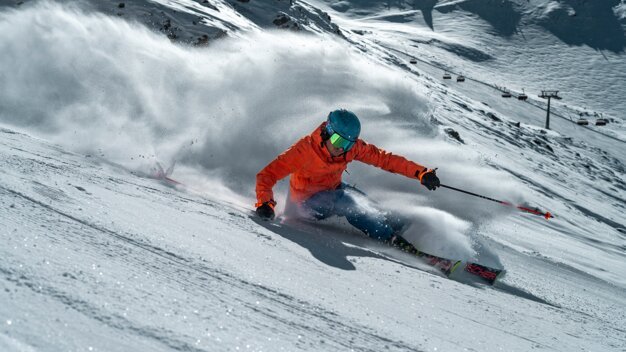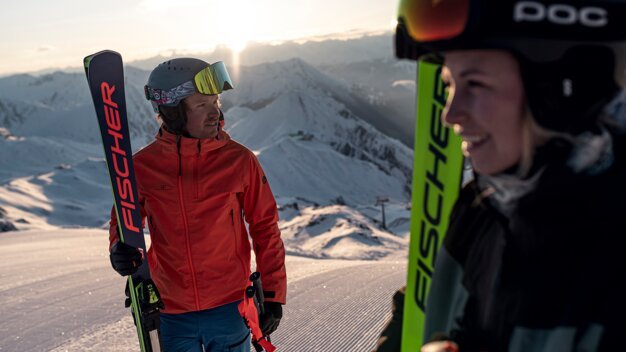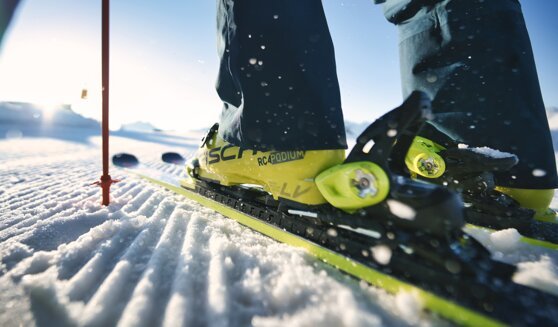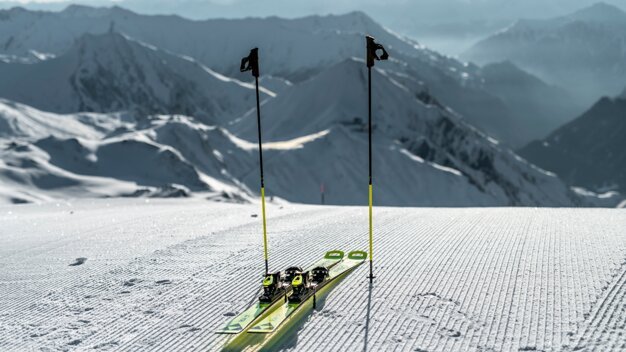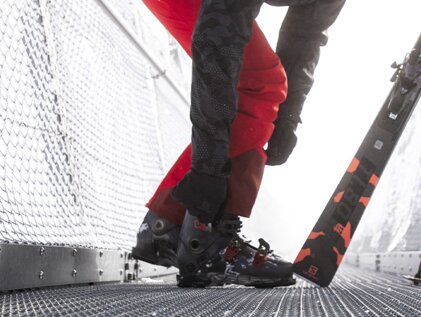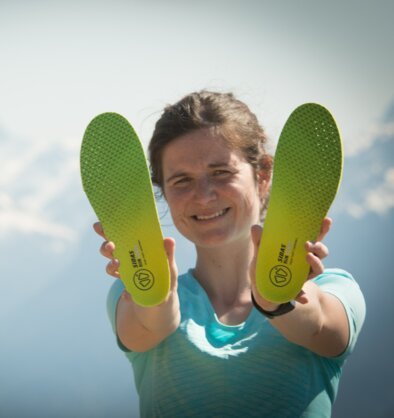
Have you ever heard of the Völkl Racetiger, the Atomic Redster, the Fischer RC4 or the Rossignol Hero? Sound impressive? Sounds like the perfect racing ski! By owning them, you don't have to win the FIS World Cup. But there should be at least a little racer in you when you strap on a pair of fast carving skis.
It's all about fast speeds, steep descents and tough slopes. But what exactly makes the perfect race ski that feels most comfortable in the conditions described? Are race skis the right ones for you? And what should you consider when choosing the perfect model?
Our winter sports experts, the RENTertainers, provide you with the most important facts about race carvers - no matter where you're travelling from to conquer the slopes of the Alps. INTERSPORT Rent has the perfect equipment for you in your favourite ski resort!
What is the difference between racing skis and normal skis?
The main differences between racing skis and conventional models are determined by the following aspects:
- Construction/design: in contrast to conventional ski models, they usually have a less pronounced centre width, which gives them a larger turn radius (20 to 30 metres). All-round carvers usually allow a radius of 12 to 18 metres.
- Materials: Resources such as tetanal or carbon are used to develop particularly stiff skis.
- Ski behaviour: Racing skis require a lot of power and a sensitive skiing technique to maintain edge pressure even at high speeds. "Normal" skis, on the other hand, are rather easy to control.
- Regulations: The perfect racing skis are usually designed to meet all the requirements of organisations such as the FIS so that they can be used in official races.
In contrast to conventional models, racing skis are designed for maximum precision, edge grip and speed. “Normal” carving skis focus on comfort, versatility and easy handling.
What is a race ski?
For all slalom fans and speed hunters: race skis or race carvers are the high-speed stars among the various models. These sporty skis deliver the best performance in tough conditions. Depending on the race format the following aspects vary:
- Some race skis are designed for medium-wide carving turns.
- Other models are ideal for really large and sweeping turn radii at maximum speed.
What is not a race ski? Although the perfect race ski really comes into its own in the right situations, such as in the World Cup, a race model is less suitable for a relaxing day on the slopes. The fast planks are neither intended for wedel runs with tight turns nor for trips into the backcountry. Beginners should also steer clear of them.
Racing skis are the right choice for your sport if ...
- you have high expectations of yourself and your skis.
- you like to ski fast and aggressively.
- you are a very active skier who expects constant feedback from the terrain.
- wide, fast and precise turns are your thing.
- you are a very good, experienced and ambitious athlete.
- you have a lot of strength in your thighs.
- you prefer to conquer hard, groomed slopes.
- you strive for perfect skiing technique.
- you want to have full control of your skis even at high speeds.
- you don't want to compromise on safety in the rush for speed.
What characterises racing skis?
The construction of the racing skis is similar to that of classic slalom skis: they are long, low-waisted and therefore ideal for wide turn radii (up to 30 metres). Thanks to their high torsional rigidity and hard flex, they are extremely stable and smooth-running at high speeds. Thanks to their sharp edges, race skis offer perfect grip on hard groomed slopes and can also be optimally steered on icy surfaces.
For comparison: The characteristics of race carvers differ significantly from the visibly shorter and more waisted slalom carvers (turn radius around 13 metres). Accordingly, you are more manoeuvrable on slalom skis and require less effort. A case for all those who prefer fast, crisp turns.
The ideal ski length for the perfect racing ski
The perfect racing ski may well reach your body length or even exceed it. Slalom carvers, on the other hand, only reach about as far as your shoulder. Due to its shortness, this type of ski would start to flutter at high speeds and lose stability. However, larger skis are more stable and easier to control at higher speeds, due to their longer effective edge.
But remember: body size is only one individual selection criterion in relation to ski length - alongside your weight, ability and preferred skiing style and terrain.
The features of race carvers at a glance
We have summarised the most important features of a race ski below:
- Low waist
- Large radius
- Long ski length
- High torsional rigidity
- Hard flex
Differences between racing skis for men and women
There are subtle differences in the high-speed models to enable consistent performance of the perfect racing ski between the genders. Race skis for women, for example, are designed so that the binding is mounted further forwards. This is due to the fact that women's centre of gravity is generally further back than that of men. Consequently, the mounting point for men moves further back. The different position of the binding enables the same performance and improved power transmission between the models.
Rent the perfect racing skis at INTERSPORT Rent
INTERSPORT Rent equips you with the top ski models from leading international winter sports brands. Test the latest racing skis from Atomic, Völkl, Fischer and Rossignol on the steepest, iciest and most notorious slopes in the world's best ski resorts! Here you can get a first impression of what characterises the "speedsters" of the individual brands. You can easily find out which racer suits you best thanks to on-site advice from the RENTertainers. We will now show you which models you can expect:
Atomic Redster
At Atomic, the Redster is synonymous with racing in the snow. The race ski has its roots in competing - which is why it incorporates genuine World Cup technologies. Characteristic of the Atomic Redster is the Revoshock technology, which minimises bumps and vibrations.
Conclusion: All in all, this revolutionary racing ski stands for maximum acceleration when turning and top stability despite high speed.
Rossignol: Hero
The Hero from Rossignol is the alpine racing ski for top and high-performance athletes. It goes without saying that the various race models in the Hero series comply with the international FIS regulations. The narrow, stiff race skis are recommended for experienced winter sport enthusiasts who value state-of-the-art equipment. If you have a perfect command of technique and are always looking for optimisation, the Rossignol Hero in its various versions is the right race carver for you!
Völkl: Racetiger
Aggressive, narrow and trimmed for maximum speed and bite - this is the best way to characterise the racing skis from the Völkl Racetiger family. Developed over generations, these models combine tradition and innovation. The result: full control and optimum power transmission for dynamic and powerful skiing.
Made for winners: The Racetiger slalom ski is also available as a World Cup version (Racetiger GS WC).
All the required ski equipment for racers
If you ski for racing, then all your equipment should be geared towards speed and control. The winter sports experts at INTERSPORT Rent will equip you from head to toe for the hunt for speed on the slopes. We offer you first-class racing gear and everything that goes with it:
Bindings for racing skis
Ideally, your ski bindings should come from the same manufacturer as your race skis. Regardless of whether they are already fitted or not, you must not make any compromises when it comes to the binding! They are a safety-relevant feature in sport: in the event of a fall, your binding should release so that you don't injure yourself. This is even more important for high-speed skis than for other models.
Therefore, always have the binding adjusted by a specialist. The correct setting depends on many factors. For example, your height, weight, skiing ability and style.
Tip: Use the RENTertainer ski service. They not only fit the bindings in the right place, but also customise the correct Z-value for you.
Ski boots for ski racers
Race ski boots must guarantee precise power transmission and maximum control. And the stiffer they are, the more likely they are to have these properties. The value that provides information about this is the flex. Conversely, however, this also means that ski boots for ski racers are significantly less comfortable than a "normal" ski boot.
Race ski poles
Ski poles for racers are as robust as they are light. They have to withstand extreme speeds and must not be a nuisance to the skier. Manufacturers therefore usually use a mixture of lightweight carbon and strong aluminium. Ideally, a racing ski pole should have a non-slip and ergonomic grip so that it sits comfortably and securely in the hand.
Ski helmets for racing
A ski helmet for racing must fulfil the highest safety standards and meet the special requirements of competitive sports. In addition to the normal safety guidelines that must be met, an additional specification label is mandatory for official FIS races. This guarantees that the helmet can withstand even greater forces. In addition, the ski helmet must fit firmly and comfortably and must not slip during movement. Modern safety technologies such as MIPS can provide additional protection, but are not a must for certification.
Frequently asked questions about the perfect racing ski
Which skis are forgiving when it comes to skiing mistakes?
Carving skis are generally more forgiving and considered beginner-friendly models. Materials such as aluminium make the ski flexible and are therefore intuitive to handle. A short ski length in combination with a small waist also makes steering easier.
Why do professionals use longer skis?
Professional skiers use longer skis because they are much more stable, precise, smoother at high speeds and with strong edge pressure. Disciplines such as slalom, downhill or super-G in particular require ski models that ensure optimum performance at top speed.
Are racing skis good for carving?
You can also carve with a racing ski if you have a good skiing technique. However, in contrast to pure carving skis, where the waist is more pronounced, more power and a more precise technique are required. Due to the shape of the race skis those models are primarily suited for long turns and large radii.
INTERSPORT Rent tip
The RENTertainer recommends
You are not yet completely convinced that a race ski is the right choice for you or whether a carving model is the better decision? We will be happy to advise you personally and individually in one of our INTERSPORT Rent shops! You can find our winter sports experts in more than 800 shops in Europe and Canada.
Do you already know exactly what race carver equipment you need? Then our three-step online booking is the ideal option for you! Step 1: Select the location now ...
Related articles
You may also be interested in:
